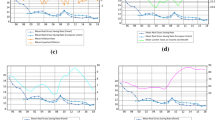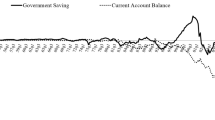Abstract
This article examines the determinants of saving rates in five Asian (Asian-5; Malaysia, Singapore, Thailand South Korea and the Philippines) countries over the 1970–2000 period. The focus is on the relationship between savings rates and foreign capital inflows before and in the financial crises. Major findings from the dynamic panel regressions are: (i) foreign savings depresses domestic savings ratio in the short as well as in the long run and the offset appears to be larger in the crisis period; (ii) real interest has a small negative effect on savings in the short and long run; (iii) the demographic factor explains a large portion of the long run trends but not the short-term fluctuations in savings rates; and (iv) high savings ratios in the countries studied is linked to the export sector.
Similar content being viewed by others
Notes
In discussing this issue, a number of authors (e.g., Edwards 1996) pointed out that the low growth rates recorded during the 1983–2000 period in Latin America was due to low saving rates (lowest in the world).
The countries were among the world’s most dynamic economies. Singapore in the only country selected for this study that experienced a current large account surplus in the 1990s.
Private capital inflows into developing countries reach a record US $ 235 billion in 1896 in comparison with US $ 50 billion in 1990 with nearly half to Asian countries. The surge of foreign capital has been perceived as welfare enhancing to the capital importing country as it allows the imported capital to smooth consumption or to finance profitable investment opportunities if the level of domestic savings was insufficient. However, the current literature has raised the issued that capital inflows, especially portfolios that might have harmful consequences and has raised policy issues. Foreign savings may be harmful because of the potential incidence of microeconomic distortions and the effect of inflows on macroeconomic stability.
It should be noted that this argument may also give rise to the possibility of a virtuous circle for countries that are successful in courting foreign.
The countries studied generally have higher saving rates compared to other regions of the world. Asian savings ratios of 27.5% over the 1982–90 periods can be compared with the savings ratio of 17.7% in Africa, 25.3% in Europe, and 23.1 in the Middle East.
For a full account on capital inflows to the developing economies, see for example Calvo et al. (1993).
Dependency ratio is defined as the population under 15 and over 64 divided the population aged 15–64.
There is now an extensive literature that discusses on this issue (see Edwards 1995; Faruquee and Husain 1995; Japelli and Pagano 1994). An important conclusion that has emerged from these studies is that dependency ratio has an important role in determining a nation’s savings behavior irrespective of the stage of economic development.
Six major determinants were considered in that analysis and they included the fiscal variable, demographics, GDP growth rate, level of per capita income, the rate of inflation, the interest rate and the change in term of trade.
Notice that the actual number of observations used in the analysis depends on the number of lag and lead variables used in the estimation. The integer k, the number of lags (or leads) is chosen as follows. Starting with a reasonable upper bound k, on estimation, if the variable (with the highest lag) is significant, then k is chosen as the optimal number of lags (or lead). If the variable is insignificant, the number of lags (leads) is reduced by one until the last lag (lead) is significant in the estimation.
Indonesia was excluded from the panel due to data problem. Some variables used in the model were unavailable over the entire sample period.
All data used in this paper are annual frequency observations. It is now well known that as far as the ability of cointegration is concerned, the span of the data is more important than the number of observation (see Hakkio and Rush 1989; Hendry 1987; Cambell and Perron 1991). Some authors (e.g., Arize and Shwiff 1998) argues that it is preferable to use data sets containing fewer annual observations over a long time period than data sets containing more observations over a short time period for cointegration analysis.
We also employed Hendry’s general-to-specific methodology, by testing down the general model to a preferred smaller model by eliminating those variables with low t-ratios. The results show that the two variables (M2/GDP and per capita income-PC) are insignificant in the panel regression at standard significance levels.
It is well known that in small samples the trace and λ-max statistics can only be used as a guide and usually yield more vectors if the degree of freedom correction factor was ignored. This issue of finite sample bias is addressed by the use of the Reinsel–Ahn corrected likelihood ratio test statistics. However, the works by Johansen (1995) and and Doornik and Hendry (1994) point out that it is unclear yet whether this is the preferred correction (Reinsel and Ahn 1992). Given that our results suggest a unique vector in the savings system, we do not have the problem of identifying the equation that supposedly presents the process whereby savings is determined in the long run.
Notice that effect of exports on savings appears not uniform across the two regimes. The magnitude of the coefficient on exports fall by more than half in the post-crisis period.
A note of caution is needed with regard to the results in the post-crisis era in this paper. While the method employed has been well refined and can reasonably invite confidence, the data span may not be good enough. The small sample available for the post crisis period is a problem and may have biased our results.
Several authors have pointed out that economic growth is an endogenous variable in the savings model. To correct for the possible endogenity in the variable, we replaced the growth variable with its lagged value. The empirical results did not change and excluding this variable from the model did not appear to have affected our results.
Note that the capital outflows are mainly short-term capital. FDI remains largely unaffected by the crisis. We observed that the banking crisis as a result of the capital outflows during the post crisis era.
References
Arize AC, Shwiff SS (1998) The appropriate exchange-rate variable in the money demand of 25 countries: an empirical investigation. N Am J Econ Finance 9:169–185
Attanasio P, Browning M (1995) Consumption over life cycle and over the business cycle. Am Econ Rev 85(5):1187–1937
Baharumshah AZ, Rashid S (1999) Exports, imports and economic growth: empirical evidence based on multivariate time series. Asian Econ J 13(24):389–406
Calvo G, Leiderman L, Reinhart C (1993) Capital inflows and the real exchange rate appreciations in Latin America: The role of external factors, 40(1), IMF Staff Papers
Campbell J, Perron P (1991) Pitfalls and opportunities: what macroeconomists should know about unit roots, NBER Macroeconomic Annual. MIT Press, Cambridge, Massachusetts
Carroll CD, Weil DN (1994) Saving and growth: a reinterpretation. Carnegie-Rochester Conference Series on Public Policy 40:133–192
Doornik JA, Hendry DF (1994) PC-GIVE and PC-FIML Professional, Version 8: An Interactive Econometric Modelling System. International Thomson, London
Edwards S (1995) Why are saving rates so different across countries? An international comparative analysis, NBER Working Paper 5097, National Bureau of Economic Research, Cambridge
Edwards S (1996) Why are Latin America’s savings rates so low? An international comparative analysis. J Dev Econ 51:5–44
Faruquee H, Husain A (1995) Saving trends in Southeast Asia: a cross country analysis, International Monetary Fund Working Papers, No. 39. Washington, International Monetary fund
Fry MJ (1994) Malaysia’s inverse saving-investment correlation. The role of public and foreign direct investment. In: Balasubramanyam VN (ed) The Economic of International Investment. Baltimore University Press, John Hopkins, Baltimore
Fry MJ (1995) Financial development in Asia: some analytical issues. Asian-Pacific Econ Literature 9:40–57
Ganzalo J (1994) Five alternative methods of estimating long run relationships. J Econometrics 60:203–233
Gruben W, Mcleod D (1998) Capital flows, savings, and growth in the 1990s. Quart Rev Econ Finance 38(3):287–301
Hakkio CS, Rush M (1989) Market efficiency and cointegration: an application to the Sterling and Deutschmark exchange markets. J Int Money Finance 8:75–88
Haque NU, Pesaran MH, Sharma S (1999) Neglected heterogeneity and dynamics in cross-country savings regressions, IMF Working Paper-128, Washington, International Monetary Fund
Hendry DF (1987) Econometric methodology: a personal perspective, In: Bewley TF (ed) Advance econometrics. Cambridge University Press, New York
Jappelli T, Pagano M (1994) Saving, growth and liquidity constraints. Quart J Econ 109:83–109
Johansen S (1995) Likelihood based inference on cointegration in the vector autoregressive model. Oxford University Press, Oxford
Johansen S (1998) Statistical analysis of cointegration vectors. J Econ Dynam Control 12:231–254
Johansen S, Jesulius K (1990) Maximum likelihood estimation and inference on cointegration-with application to demand for money. Oxford Bull Econ Stat 54:383–397
Johansson S (1998) Life cycle, oil cycles, or financial returns? The growth in private savings rates in Indonesia. World Dev 26(1):111–124
Koa C, Chiang MH (1999) On the estimation and inference of a cointegrated regression in panel data, Working Paper, Central for Policy Research, Syracuse University
Maizel A (1968) Exports and economic growth of developing countries. Cambridge University Press, New York
Mark NC, Sul D (1999) A computationally simple cointegration vector estimator for panel data. Ohio State University, Mimeo
Masson P, Bayomi T, Samiei H (1998) International evidence on the determinants of private savings. World Bank Econ Rev 12(3):483–501
Nurhan Y (1999) Short-term capital inflows and their impact on macroeconomic structure, Turkey in the 1990s. The Developing Economies XXXVII-1:89–113
Osterwald-Lenum M (1992) A note with quartiles of the asymptotic distribution of the maximum likelihood cointegration rank test statistics: four cases. Oxford Bull Econ Stat 54:461–472
Papanek GF (1972) The effect of aid and other resource transfers on savings and growth in less developed countries. Econ J 327:934–958
Reinhart C, Talvi E (1998) Capital flows and saving in Latin America and Asia: a reinterpretation. J Dev Econ 57:45–66
Reinsel GC, Ahn SK (1992) Vector autoregressive models with unit roots and reduced rank structure: estimation, likelihood ratio tests, and forecasting. J Time Ser Anal 13(4):353–375
Rossi N (1989) Dependency rates and private savings behavior in developing countries. International Monetary Fund Papers 36:166–181
Schmidt-Hebbel K, Servén L (2000) Does income inequality raise aggregate saving. J Dev Econ 61:417–446
Stock JH, Watson MW (1989) Interpreting the evidence on money-income causality. J Econometrics 40:161–182
Wade R (1998) The Asian debt-and-development crisis of 1997: causes and consequences. World Dev 26(8):1535–1553
Whitt J (1999) The role of external shocks in the Asian financial crisis, Economic Review, Federal Reserve Bank of Atlanta, 18–31
Acknowledgements
This paper was presented at the International Atlantic Conference in Vienna, Austria and Modernization and Social Transformation in Vietnam, Hanoi. The article has benefited from the comments and suggestions by the participants of these conferences. The authors are grateful to Salim Rashid for his helpful comments on previous draft of this paper. The usual disclaimer applies.
Author information
Authors and Affiliations
Corresponding author
Rights and permissions
About this article
Cite this article
Thanoon, M.AM., Baharumshah, A.Z. What happened to savings during the financial crisis—a dynamic panel analysis of Asian-5 countries. Econ Change 38, 257–275 (2005). https://doi.org/10.1007/s10644-006-9006-9
Received:
Accepted:
Published:
Issue Date:
DOI: https://doi.org/10.1007/s10644-006-9006-9




